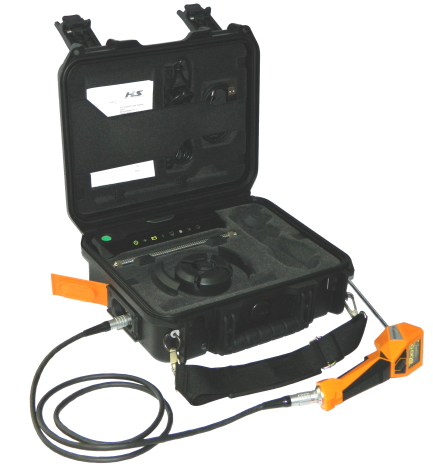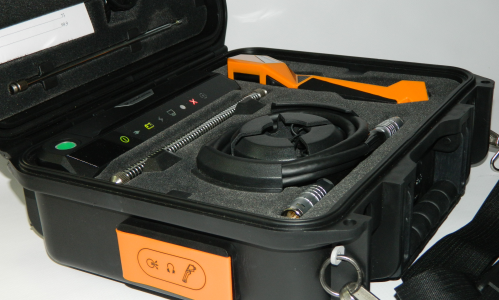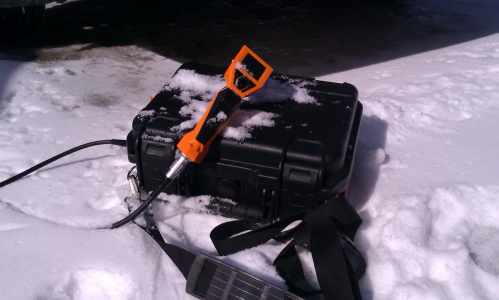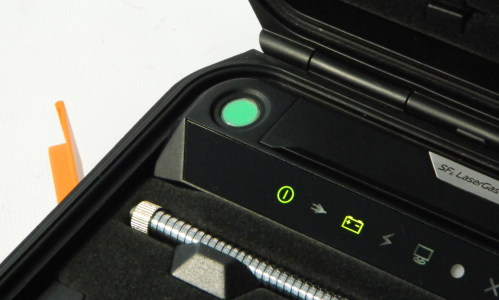Portable SF6 leak detector
SF6 LaserGasTest

Description
Insulation gas leakage detector SF6 LaserGasTest is based on laser photo-acoustic spectroscopy.
This method is well known and widely used for goals of detection of various chemicals when efficiency matters.
For example, SF6 LaserGasTest can detect the presence of about 10 ppb of sulfur hexafluoride, which is equivalent to the detection of a sulfur hexafluoride molecules of the 100 000 000 (one hundred million) of air molecules.
High speed of the gas flow and small response time of photo-acoustic detector reduce system recovery time to 1-2 seconds when high concentrations are detected.
CO2-laser as laser radiation source and spectral photo-acoustic detection method provide high SF6 detection selectivity.
It reduces the number of false alarms. The system detects only compounds having high absorption at 10.6 μm wavelength. The absorption coefficient of SF6 is 2-3 orders higher than those of other admixtures in the air.
Special technologies, Ltd. in cooperation with HLS Hypertech Laser Systems GmbH represented at international exhibition SENSOR+TEST 2012 in Nurnberg (Germany, 21-23 May) a serial version of a brand new high-sensitive portable SF6 leak detector - SF6 LaserGasTest.
Today, SF6 LaserGasTest is delivered to Russia, Japan, Germany and China.
Leak detector is intended for technological leak-tightness control of the equipment and parts containing sulfur hexafluoride SF6 for precise leakage localization.
It is important to note that insulating gas under the Kyoto Protocol relates to greenhouse gases and has a significant impact on climate change.
Applications of SF6 LaserGasTest:
SF6 LaserGasTest is intended for control of the equipment condition in different areas:
— on the power facilities (high-voltage gas-insulated measuring transformers of current and voltage, switchgears, high-voltage circuit breakers, SF6 isolated high voltage cables);
— building industry (leakage testing of the SF6-filled double-glazed windows);
— control of the fire extinguishing systems, where SF6 is used as an extinguishing substance;
— gas-filled RF waveguides leakage control;
— air-tightness control of complex, distributed pneumo- or hydraulic pipe systems.
Specification
| Characteristic | Value | |
|---|---|---|
| Detected gas | SF6 | |
| Sensitivity for SF6 | 1 ppb or 0.002 g/year | |
| Range | 10 ppb — 5000 ppm | |
| Gas flow speed | 0.55 l/min | |
| Response time | < 2 s | |
| Readness time | < 0.5 min | |
| Leakage indication | OLED display, sound | |
| Internal memory | 16 records up to 4093 results each | |
| Power consumption (max) | 90 W | |
| Continuous operation time | more than 8 hours | |
| Dimensions Main block Probe Telescopic intake Flexible intake |
370 × 330 × 170 mm 220 × 65 × 80 mm 220 — 980 mm 210 mm | |
| Weight System block Probe |
7 kg 0.3 kg |
SF6 LaserGasTest is designed for indoor and outdoor applications
— IP65 class of protection (in closed condition);
— mechanical shock and vibration resistant;
— gloved hand friendly operation;
— RоHS and CE compliant.
"LaserGasTest PC Application" software
— free of charge, included in package;
— results indication;
— full remote control;
— stored results management.
System requirements:
— CPU: Intel Pentium®, 1 GHz;
— RAM: 512 Mb;
— Screen resolution: 1024×768 min.;
— ОС: Microsoft® Windows® XP®;
— Microsoft® .NET Framework platform 4.0.
Publications
Sherstov I. V., Vasiliev V. A., Karapuzikov A. I., Zenov K. G., Pustovalova R. V. Reducing the Energy Consumption of a Laser Photo-Acoustic SF6 Gas Analyzer // Instruments and Experimental Techniques. – 2018. – Vol. 61, No. 4 – P. 583-589
DOI: 10.1134/S0020441218030259
Sherstov I. V., Vasiliev V. A., Zenov K. G., Pustovalova R. V., Spitcin V. V., Chernikov S. B. Development and research of a laser photo-acoustic SF6 gas analyzer // Instruments and Experimental Techniques. – 2017. – №60, Issue 3. – P. 407-413
DOI: 10.1134/S0020441217030253
Karapuzikov A. A., Karapuzikov A. I., Kashtanov D. A., Miroshnichenko I. B., Sherstov I. V. A compact frequency-stabilized pulse-periodic waveguide CO2 laser for calibration of wavelength meters // Instruments and Experimental Techniques. – 2014. – №57, Issue 2. – P. 209-213


